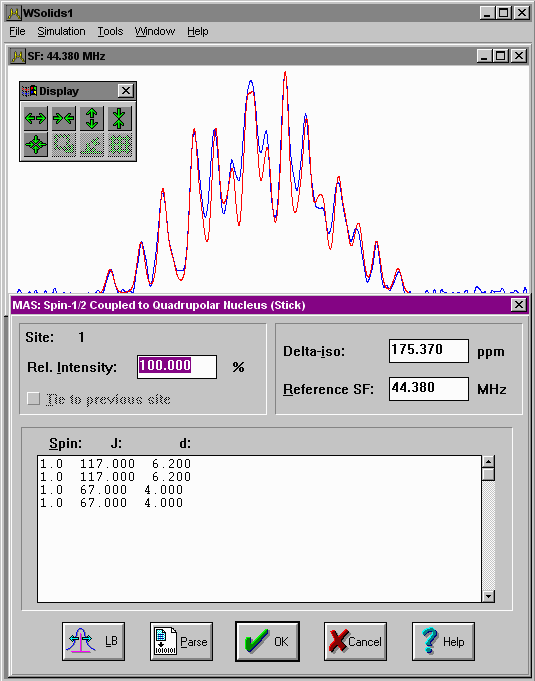[Uni Tübingen] - [Mat.-Nat. Fakultät] - [Fachbereich Chemie] - [Anorg. Chemie] - [Klaus Eichele] - [Software] - [WSolids1] - Spin-1/2--Spin-S

|
WSOLIDS1:
|
Description
The multiplets shown on this page actually triggered the development of WSolids1, starting with a Fortran version for MS DOS! The analysis by hand simply became too tedious.
This squeezed picture shows an example for the succesful simulation of a MAS spectrum of a spin-1/2 nucleus that is coupled to several quadrupolar nuclei in a powder sample. It is the 113Cd MAS NMR spectrum of (NMe4)2[Cd(SCN)4], where the octahedral cadmium is coupled to four N-14 nuclei, and the results have been published in:
K. Eichele, R. E. Wasylishen:
High-Resolution 113Cd CP/MAS NMR Studies of Cadmium Thiocyanate
Coordination Compounds. Direct Observation of 113Cd,14N Spin-Spin
Coupling Constants in the Solid State.
Inorg. Chem. 1994, 33, 2766-2773.
Click on the picture to have a better look.
Background
The quadrupolar interaction at a quadrupolar nucleus causes its axis of quantization to be tilted away from the direction of the external magnetic field. This also modifies the spatial dependence of the dipolar interaction, so that magic-angle spinning is not able to suppress the heteronuclear dipolar coupling in the spectrum of the spin-1/2 nucleus, resulting in splittings and broadenings. Similar effects can be transmitted through the indirect spin-spin coupling. If the nuclear quadrupolar coupling constant is on the same order of magnitude as the Larmor frequency of the quadrupolar nucleus, the combined Zeeman-quadrupolar Hamiltonian must be diagonalized at each orientation and averaged over a rotor period to calculate a theoretical spectrum. However, if the quadrupolar and dipolar coupling are small relative to the indirect spin-spin coupling, this so-called breakdown of the high-field approximation causes no significant broadening of the individual peaks, only unequal spacings between the peaks of the multiplet. Such spectra can be simulated using first-order perturbation theory with a stick approach, where the patterns are characterized by an indirect spin-spin coupling constant, J, and a residual dipolar coupling, d.
Examples
The SVG images shown below were produced using the following tools: my own SpecPlot to plot the spectra, Platon to plot the molecular structures from X-ray data, and Inkscape to compose the picture.
| Cd-113 MAS NMR spectrum of a powder sample of Cd(SCN)2: this example illustrates the coupling to two different N-14 nuclei. This example has been shown in the paper quoted above. |
| Cd-113 MAS NMR spectrum of a powder sample of NaCd(SCN)3 trihydrate: this example illustrates the coupling to three equivalent N-14 nuclei. This example has been shown in the paper quoted above. |
| Cd-113 MAS NMR spectrum of a powder sample of (NPr4)Cd(SCN)3: this example illustrates the coupling to three non-equivalent N-14 nuclei. This example has been shown in the following paper: K. Eichele, R. E. Wasylishen: Indirect 113Cd,14N Spin-Spin Coupling Constants as a Structural Probe of Solid Cadmium Thiocyanate Complexes. Angew. Chem., Int. Ed. Engl. 1992, 31, 1222-1224. |
[ Anorg. Chemie ] | [ Go Home ] | webm@ster | last modified: 28.05.2024


